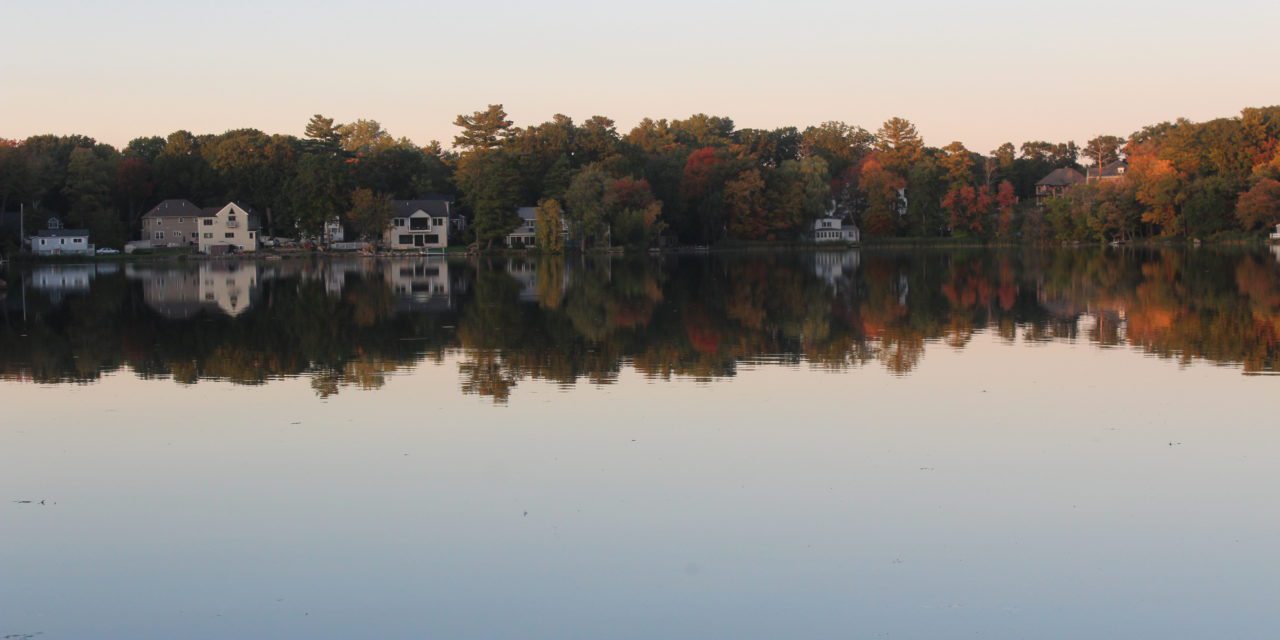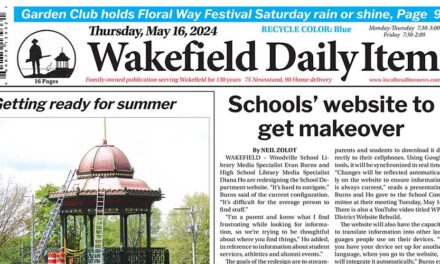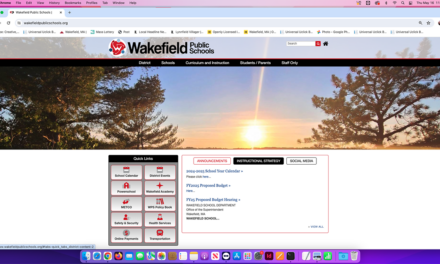THE PILLINGS POND SUBCOMMITTEE is looking to have a study undertaken that will identify the various problems that have been occurring at Pillings Pond and ways to address them, including dredging. (Dan Tomasello Photo)
By DAN TOMASELLO
LYNNFIELD — The Select Board expressed its support for a proposed feasibility that will seek to address the water quality problems plaguing Pillings Pond.
Pillings Pond Subcommittee member Joe DiBlasi told the Select Board and a large group of pond abutters last week that the Conservation Commission formed the subcommittee a few years ago.
“We monitor the work that is done on the pond, including the different treatments that are used,” said DiBlasi. “Over the last few years, we have been looking at ways to improve the health of the pond. There are a lot of different remedial ways to do that, but one of the few ways to set the clock back would be dredging.”
DiBlasi said the subcommittee wants a feasibility study conducted for the pond. He said the subcommittee has been working with Waltham-based ESS Group, Inc., which is a subsidiary of TRC Companies, Inc.
“The feasibility study would use scientific facts and data to let us know the possibility from a logistical standpoint and a financial standpoint,” said DiBlasi.
DiBlasi said eutrophication is “a process by which an entire body of water or parts of it becomes progressively enriched with minerals and nutrients, particularly nitrogen and phosphorous.”
“Excessive richness of nutrients in a lake or other body of water, frequently due to runoff from the land, causes a dense growth of plant life and potentially the death of animal life from a lack oxygen,” said DiBlasi. “I am not saying Pillings Pond has reached the point of eutrophication, but there is a good amount of information that supports the idea that this process is happening.”
DiBlasi said Pillings Pond, which is manmade, is “slowly filling in.”
“There are people who have lived on the pond for decades who told us that they used to jump in and go swimming on the west end,” said DiBlasi. “There used to be 10-feet of water there, and now there is less than a foot. Pillings Pond is a developed asset that was made over 100 years ago, and it requires care and maintenance. It needs some care.”
DiBlasi said Pillings’ Pond’s water quality is “deteriorating.” He recalled that the state Department of Public Health notified the town in August there was a potentially harmful algae bloom at Pillings Pond. While algae blooms occur seasonally, the combination of high temperatures and the drought made the problem worse last summer. Similar to previous years, the Conservation Commission treated the algae problem once again last summer. DiBlasi said Pillings Pond has had issues with invasive spiny naiad and other types of algae over the years.
“It’s a risk to wildlife as well as the health and safety for people and pets,” said DiBlasi. “It’s also a risk to property values. If the pond fills in and becomes a swamp, I don’t think that would benefit the property values of the 128 shoreline abutters and the community at-large.”
DiBlasi said the town taped signs to trees that warned Rotary Park visitors not to swim, swallow water and to keep pets away from Pillings Pond due to the algae problems that occurred this summer.
“It’s pretty bad,” said DiBlasi. “Algae blooms and invasive plant growth happens as part of the eutrophication process. As that algae dies and falls down to the bottom of the pond, it deprives the water of oxygen. It can become a real problem if not treated.”
Patrice Lane resident Pat Campbell requested that the town post larger signs at Rotary Park to warn residents walking their dogs as well as people fishing about the algae problem and its harmful effects.
DiBlasi said ESS Group, Inc. “completed a desk and field assessment of Pillings Pond in May.”
“They delivered a historical review and field mapping assessment of the pond’s current state,” said DiBlasi. “ESS does quite a bit of work in Massachusetts and Rhode Island, and has a lot of expertise with watershed management and environmental issues.”
DiBlasi said ESS Group, Inc. worked to improve Winchester Country Club’s irrigation system and completed Concord’s White Pond restoration plan.
After the assessment was completed, DiBlasi, Pillings Pond Subcommittee Chairman Kirk Mansfield and subcommittee member Antonio Sordillo participated in a follow-up discussion with ESS lead scientist Carl Nielsen and staff scientist James Treacy.
“They proposed the feasibility study to us,” said DiBlasi. “ESS Group, Inc. was recommended by the U.S. Army Corps of Engineers.”
DiBlasi said ESS Group, Inc. recommended that four tasks be undertaken as part of the feasibility study, which will tentatively cost $43,500. He said the first task involves undertaking fieldwork, which will cost $19,400.
“They will use CAD mapping to give us an idea of what the sediment and water depths are,” said DiBlasi. “They are also going to create a GIS map that will give us a full map of the contour of the pond and what lies underneath as far as sediment is concerned. They will also take nine sediment cores as well as three composite sediment samples for analysis. They will wash out all of the sediment, which will help us find out what we are exactly dealing with.”
DiBlasi said the second task ESS Group, Inc. will undertake is determining what federal, state and local permits the town will need to receive for a Pillings Pond dredging project. He said permit identification component of the study will cost $3,000.
“ESS Group will identify potential permitting strategies for the project once we have a better understanding of the various options for sediment removal, re-use, scale of the potential project and the resources that may be impacted,” said DiBlasi.
DiBlasi said the third task will be completing the dredging feasibility study, which will cost $18,000.
“ESS Group will conduct a dredging feasibility study that will include the estimation of sediment depths and the discussion of sediment characteristics,” said DiBlasi. “It will also include an estimate of the volume of soft sediment and locating potential de-watering sites and dredge methodologies. It will also provide up to two conceptual designs for the dredge project envisioned by the town, and will include a rough order of magnitude cost estimates and a timeline for potential dredging projects at the site.”
DiBlasi said the fourth and final task involves having ESS Group, Inc. give a presentation to town officials, which will cost $3,100.
“We met with the Conservation Commission, and they voiced their support for this study,” said DiBlasi. “We are asking for the Select Board’s support.”
While DiBlasi said there are “many unknowns” surrounding the issues with Pillings Pond, he said, “Dredging is a highly effective option in combating eutrophication.”
“The information obtained through this study will provide tangible information for the town,” said DiBlasi. “Without dredging, it will fill in over a period of time. It’s better to get ahead of it now rather than waiting until we have a real problem. Pillings Pond is beloved for its wildlife and recreation. I think we owe it care.”
Select Board Chairman Phil Crawford said he recently went on a pontoon boat tour of Pillings Pond with members of the Village Home and Garden Club a few months ago.
“I have lived in town for 35 years and this was the first time I have been on a pontoon boat in the pond,” said Crawford. “It’s beautiful. I noticed from the depth finder that the west side of the pond was 20-feet deep and the east side of the pond was 2-feet deep. It obviously needs some attention.”
Select Board member Joe Connell said he supported undertaking the feasibility study because it will outline what steps the town needs to take to address the problem.
“Pillings Pond is without question a highlight of the town,” said Connell.
Select Board member Dick Dalton recalled that he went on a pontoon boat tour of Pillings Pond along with former Selectman/current Historical Commission member Bob MacKendrick and a group of Rotarians several years ago.
“I never realized what a beautiful natural asset Pillings Pond is for the town,” said Dalton. “I fully support moving forward with the study. It is incumbent on us to protect the town’s natural resources.”
Crawford said the feasibility study could be funded in either the town’s fiscal year 2024 capital budget or by a state grant. He said House Minority Leader Brad Jones (R-North Reading) and State Sen. Brendan Crighton (D-Lynn) have been very successful with securing state grants for town projects in the past.
“You will certainly have the support of the board,” said Crawford.
The 1990s Pillings Pond dredging project resulted in the
Environmental Protection Agency ordering the town to pay a $36,000 fine for illegal dredging and filling activities that violated the Clean Water Act.





